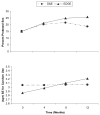Efficacy of a behavioral intervention for increasing safer sex behaviors in HIV-positive MSM methamphetamine users: results from the EDGE study
- PMID: 17182196
- PMCID: PMC1904343
- DOI: 10.1016/j.drugalcdep.2006.08.026
Efficacy of a behavioral intervention for increasing safer sex behaviors in HIV-positive MSM methamphetamine users: results from the EDGE study
Abstract
Background: Methamphetamine use has been associated with rising STI/HIV transmission rates, particularly among men who have sex with men (MSM). Interventions which successfully reduce risk for HIV transmission among this population are a public health priority. This study examined the efficacy of a behavioral intervention for increasing safer sex behaviors in the context of ongoing methamphetamine use in a sample of HIV-positive, methamphetamine-using MSM.
Methods: Three-hundred and forty-one participants from San Diego, CA were randomly assigned to receive either a safer sex behavioral intervention (EDGE) or a time-equivalent diet-and-exercise attention-control condition. Random effects regression analyses were used to evaluate change in safer sex behaviors over a 12-month period.
Results: Participants in the EDGE intervention engaged in significantly more protected sex acts at the 8-month (p=0.034) and 12-month assessment (p=0.007). By 12-months post-baseline, a greater percentage of protected sex acts was observed for EDGE (25.8%) vs. control participants (18.7%) (p=0.038). There was a significant time-by-intervention interaction (p=0.018) for self-efficacy for condom use, suggesting that EDGE participants' self-efficacy demonstrated a greater increase over time compared to control participants.
Conclusions: These results suggest that it is possible to reduce high risk sexual behaviors in the context of ongoing methamphetamine use among HIV-infected MSM.
Figures


Similar articles
-
Efficacy of a behavioral intervention for increasing safer sex behaviors in HIV-negative, heterosexual methamphetamine users: results from the Fast-Lane Study.Ann Behav Med. 2007 Nov-Dec;34(3):263-74. doi: 10.1007/BF02874551. Ann Behav Med. 2007. PMID: 18020936 Clinical Trial.
-
Methamphetamine-using HIV-positive men who have sex with men: correlates of polydrug use.J Urban Health. 2005 Mar;82(1 Suppl 1):i120-6. doi: 10.1093/jurban/jti031. Epub 2005 Feb 28. J Urban Health. 2005. PMID: 15738313 Free PMC article.
-
Gender differences in the perceived self-efficacy of safer HIV practices among polydrug abusers in Taiwan.Compr Psychiatry. 2011 Nov-Dec;52(6):763-8. doi: 10.1016/j.comppsych.2010.10.015. Epub 2010 Dec 30. Compr Psychiatry. 2011. PMID: 21195395
-
Methamphetamine use and infectious disease-related behaviors in men who have sex with men: implications for interventions.Addiction. 2007 Apr;102 Suppl 1:130-5. doi: 10.1111/j.1360-0443.2006.01775.x. Addiction. 2007. PMID: 17493062 Review.
-
Eroticizing creates safer sex: a research synthesis.J Prim Prev. 2006 Nov;27(6):619-40. doi: 10.1007/s10935-006-0059-3. J Prim Prev. 2006. PMID: 17051432 Review.
Cited by
-
A comparison of the social and sexual networks of crack-using and non-crack using African American men who have sex with men.J Urban Health. 2011 Dec;88(6):1052-62. doi: 10.1007/s11524-011-9611-4. J Urban Health. 2011. PMID: 21882072 Free PMC article.
-
Survival Tactics and Strategies of Methamphetamine-Using HIV-Positive Men Who Have Sex with Men in San Diego.PLoS One. 2015 Sep 30;10(9):e0139239. doi: 10.1371/journal.pone.0139239. eCollection 2015. PLoS One. 2015. PMID: 26421928 Free PMC article.
-
Sexual Arousal-Delay Discounting: When Condoms Delay Arousal.J Sex Res. 2024 May-Jun;61(5):727-741. doi: 10.1080/00224499.2023.2239216. Epub 2023 Jul 28. J Sex Res. 2024. PMID: 37506314 Free PMC article.
-
Predictors of sexual risk reduction among Mexican female sex workers enrolled in a behavioral intervention study.J Acquir Immune Defic Syndr. 2009 May 1;51 Suppl 1(Suppl 1):S42-6. doi: 10.1097/QAI.0b013e3181a265b2. J Acquir Immune Defic Syndr. 2009. PMID: 19384101 Free PMC article.
-
Assessing the Effectiveness of an mHealth Intervention to Support Men Who Have Sex With Men Engaging in Chemsex (Budd): Single-Case and Pre-Post Experimental Design Study.JMIR Form Res. 2024 Oct 4;8:e56606. doi: 10.2196/56606. JMIR Form Res. 2024. PMID: 39365642 Free PMC article.
References
-
- Ajzen I. The Theory of Planned Behavior. Organ Behav Hum Decis Process. 1991;50:179–211.
-
- Bandura A. Social Learning Theory. Prentice Hall; Englewood Cliffs, NJ: 1977.
-
- Bandura A. Social Foundations of Thought and Action: A Social Cognitive Theory. Prentice Hall; Englewood Cliffs, NJ: 1986.
-
- Bandura A. Social cognitive theory and exercise of control over HIV infection. In: DiClemente R, Peterson J, editors. Preventing AIDS: Theories and Methods of Behavioral Interventions. Plenum Publishing Corp; New York: 1994. pp. 25–59.
-
- Bandura A. Self-efficacy: The exercise of control. W. H. Freeman; New York: 1997.

